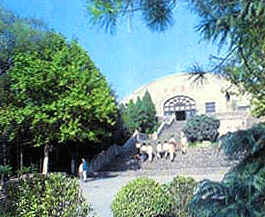 In the present-day Banpo village, about five kilometers to the east from Xi’an, lies the actual and complete archaeological site of a Neolithic village---the Banpo Site, dating back to 6000 years. It is a typical village of that time, discovered in the spring of 1953. Later, after five large-scale digs of excavation organized by Chinese Academy of Sciences, an area of approximate 10,000 square meter was excavated, covering one fifth of the total site area. Among the excavated finds are 45 house sites, 2 penned sites, 6 pottery-making kilns, over 200 stronge pits, over 250 burial jars of adults and children, over 1,000 pieces of tools and utensils, as well as thousands of kernels, animal bones and rotten millets. An on-the-site museum was set up here in 1985, and named after the present place where it was discovered "Xi’an Banpo Museum". Apart from the relic exhibition rooms, a 3,000 square-meter on-the-site great hall of the remains was set up for protection of the site. The Banpo Museum is one of the historical sites designated for state protection. In the present-day Banpo village, about five kilometers to the east from Xi’an, lies the actual and complete archaeological site of a Neolithic village---the Banpo Site, dating back to 6000 years. It is a typical village of that time, discovered in the spring of 1953. Later, after five large-scale digs of excavation organized by Chinese Academy of Sciences, an area of approximate 10,000 square meter was excavated, covering one fifth of the total site area. Among the excavated finds are 45 house sites, 2 penned sites, 6 pottery-making kilns, over 200 stronge pits, over 250 burial jars of adults and children, over 1,000 pieces of tools and utensils, as well as thousands of kernels, animal bones and rotten millets. An on-the-site museum was set up here in 1985, and named after the present place where it was discovered "Xi’an Banpo Museum". Apart from the relic exhibition rooms, a 3,000 square-meter on-the-site great hall of the remains was set up for protection of the site. The Banpo Museum is one of the historical sites designated for state protection.
The Banpo Neolithic Site consists of 3 sections: the dwelling area, the pottery-making center and the cemetery. According to archeologists’ demonstration, the Banpo inhabitants’ social organization was the matriarchal society and the villagers lived in a primitive communist society. Women were the organizers and main forces in the primitive society. They were mainly engaged in pottery-making, weaving, domestic animal rearing and farming while men mainly engaged in fishing, hunting and fighting.
Banpo Village was in the loess area, so the soil was spongy. The tools of production used by the ancestors not only include stone axes, knives, spades and hoes, but also some tools made of wood, such as digging sticks and hoes, etc.
A complete vertical pottery-making kiln is kept here and it is the oldest pottery-making kiln discovered in China up to now. The pottery wares unearthed here total up to 50 to 60 kinds, including jars for cooking, tripots, the tip-bottomed bottles for holding water, gourd-shaped pots, narrow-necked flasks, pottery bowls, ect. Some of the pottery objects were decorated with colorful geometric designs, and some were decorated with the designs of fish with a big mouth, running deer and various types of human-faced fish. It is worthwhile to mention here that some carved and painted signs were found on the unearthed pottery vessles. Are these signs incantation characters, a kind of characters or implying deeper meaning? This will be left for further investigation by the later generations.
In the north of the site, lies the communal cemetery. The adults and children were buried in different ways. The adults were found to be buried in various postures. Some were buried with their faces upwards, some were buried with their faces downwards, and some were buried with the limbs dended. The burying pits are in a proper order with burial articles in each while children were always buried in rough pottery jars near their houses. The famous archeologist Guo Moruo wrote a poem describing this as: "There are graves for children at Banpo Museum, the corpses are placed in pottery jars. A hole is chipped in each cover of the pottery coffin, and the souls can go in and out through. The burial pits are near the houses, it seems that they are still in their mothers’ bosoms. While the adults are buried without coffins, and they are buried in places of desolation. This shows the inhabitants’ love for their children and this kind of love will go from generation to generation forver." From this we can see how our ancestors loved and concerned about their children.
|